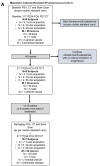Bench to Bedside Development of [18F]Fluoromethyl-(1,2-2H4)choline ([18F]D4-FCH)
- PMID: 38138508
- PMCID: PMC10745874
- DOI: 10.3390/molecules28248018
Bench to Bedside Development of [18F]Fluoromethyl-(1,2-2H4)choline ([18F]D4-FCH)
Abstract
Malignant transformation is characterised by aberrant phospholipid metabolism of cancers, associated with the upregulation of choline kinase alpha (CHKα). Due to the metabolic instability of choline radiotracers and the increasing use of late-imaging protocols, we developed a more stable choline radiotracer, [18F]fluoromethyl-[1,2-2H4]choline ([18F]D4-FCH). [18F]D4-FCH has improved protection against choline oxidase, the key choline catabolic enzyme, via a 1H/2D isotope effect, together with fluorine substitution. Due to the promising mechanistic and safety profiles of [18F]D4-FCH in vitro and preclinically, the radiotracer has transitioned to clinical development. [18F]D4-FCH is a safe positron emission tomography (PET) tracer, with a favourable radiation dosimetry profile for clinical imaging. [18F]D4-FCH PET/CT in lung and prostate cancers has shown highly heterogeneous intratumoral distribution and large lesion variability. Treatment with abiraterone or enzalutamide in metastatic castrate-resistant prostate cancer patients elicited mixed responses on PET at 12-16 weeks despite predominantly stable radiological appearances. The sum of the weighted tumour-to-background ratios (TBRs-wsum) was associated with the duration of survival.
Keywords: [18F]Fluoromethyl-(1,2-2H4)choline; cell membrane metabolism; choline; dosimetry; in vitro; in vivo; metastatic castrate-resistant prostate cancer; positron emission tomography.
Conflict of interest statement
Abiraterone was first designed and synthesized at The Institute of Cancer Research (PF and JSDB are employees), which has a commercial interest in the drug. The authors declare no conflict of interest.
Figures







References
-
- Aboagye E.O., Bhujwalla Z.M. Malignant transformation alters membrane choline phospholipid metabolism of human mammary epithelial cells. Cancer Res. 1999;59:80–84. - PubMed
Publication types
MeSH terms
Substances
Grants and funding
LinkOut - more resources
Full Text Sources
Medical
Research Materials

